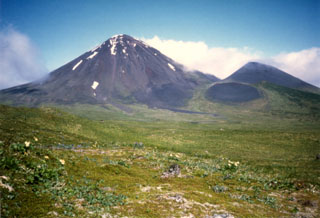Report on Semisopochnoi (United States) — 26 May-1 June 2021
Smithsonian Institution / US Geological Survey
Weekly Volcanic Activity Report, 26 May-1 June 2021
Managing Editor: Sally Sennert.
Please cite this report as:
Global Volcanism Program, 2021. Report on Semisopochnoi (United States) (Sennert, S, ed.). Weekly Volcanic Activity Report, 26 May-1 June 2021. Smithsonian Institution and US Geological Survey.
Semisopochnoi
United States
51.93°N, 179.58°E; summit elev. 1221 m
All times are local (unless otherwise noted)
AVO reported that an eruption at Semisopochnoi continued during 25 May-1 June. Steaming from the N crater at Mount Cerberus was visible in satellite images on 25 May. Radar data acquired between 15 and 27 May showed no morphological changes to the active vent. Tremor began to be recorded after AVO field engineers restored the satellite uplink to the seismic stations on 26 May. Field crews on 29 May observed low-level ash plumes rising to 2.4-3 km (8,000-10,000 ft) a.s.l., and small ash clouds drifting SW were visible in satellite images at around 0810 and 0920. Diffuse ash emissions were visible in satellite imagery at 1110. Strongly elevated surface temperatures were also identified in satellite data. Increased seismic tremor and accompanying low-level ash emissions began at 0945 on 30 May, with ash plumes drifting S at an altitude of 1.5 km (5,000 ft) a.s.l. at least through 1250. Elevated surface temperatures were detected during 30-31 May, likely from hot material on the crater floor. Seismic data showed low-level continuous tremor and occasional small discrete events. The Aviation Color Code remained at Orange and the Volcano Alert Level remained at Watch.
Geological Summary. Semisopochnoi, the largest subaerial volcano of the western Aleutians, is 20 km wide at sea level and contains an 8-km-wide caldera. It formed as a result of collapse of a low-angle, dominantly basaltic volcano following the eruption of a large volume of dacitic pumice. The high point of the island is Anvil Peak, a double-peaked late-Pleistocene cone that forms much of the island's northern part. The three-peaked Mount Cerberus (renamed Mount Young in 2023) was constructed within the caldera during the Holocene. Each of the peaks contains a summit crater; lava flows on the N flank appear younger than those on the south side. Other post-caldera volcanoes include the symmetrical Sugarloaf Peak SSE of the caldera and Lakeshore Cone, a small cinder cone at the edge of Fenner Lake in the NE part of the caldera. Most documented eruptions have originated from Young, although Coats (1950) considered that both Sugarloaf and Lakeshore Cone could have been recently active.
Source: US Geological Survey Alaska Volcano Observatory (AVO)

